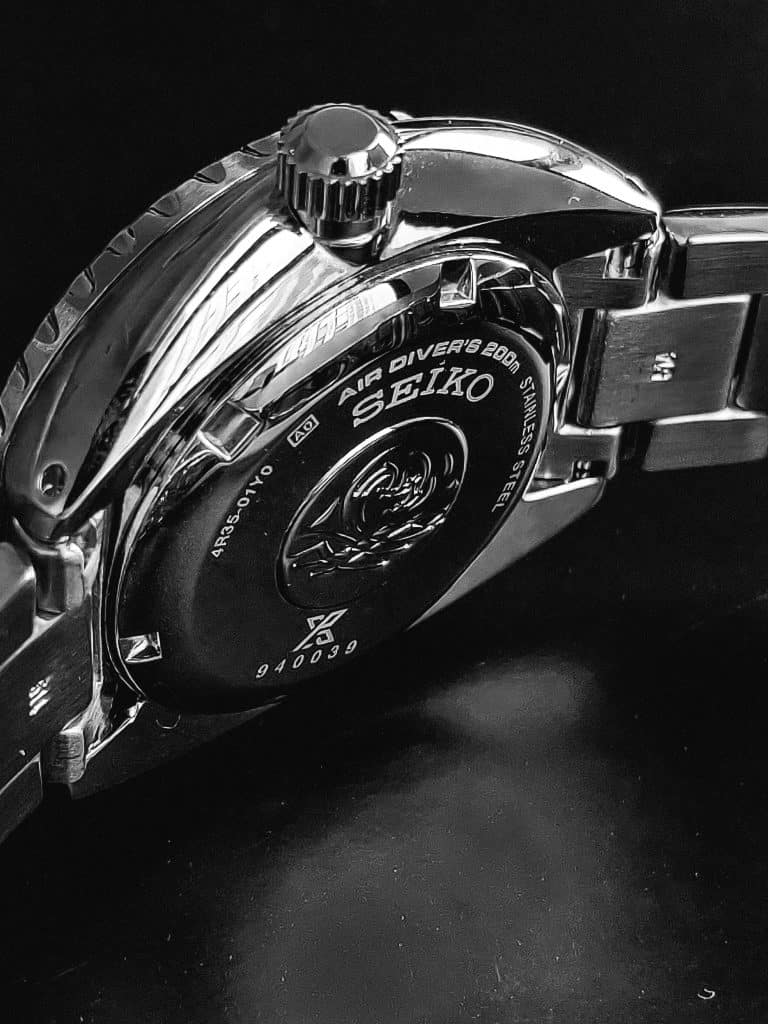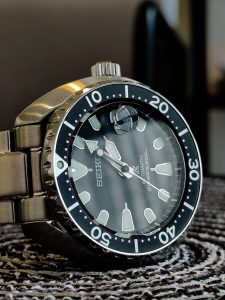Seiko fans love to give the brand’s watches fancy names that describe their appearance.
Two of Seiko’s dive watches, namely the Sumo and the Turtle, are often compared because they look like identical twins.
There are only very slight differences between the two, that they often sow confusion among buyers.
If you’re interested in buying either the Sumo or the Turtle, it would be best to equip yourself with knowledge on these two watches.
This will help you decide which one is better suited to your taste and needs.
Seiko Sumo
The Seiko Sumo is part of the Prospex collection that was released in 2007.
According to legends, the watch was named as such because of the 12 o’clock hour marker that resembles the underwear of a Sumo Wrestler.
Additionally, it has a chunky build that befits the name Sumo.
Sumo is popular among users for its high-end look and affordable pricing.
It is rather large, but it’s still comfortable to wear, thanks to the case back’s shape that fits the arm’s curvature.
The Seiko Sumo is available in two variants: the SBDC031 which has a black dial and the SBDC033 which has a blue dial.
Pros:
- Slightly smaller case compared to the Turtle
- Greater power reserve compared to the Turtle
- Crown is easier to grip
- Legible watch face
- High water-resistance rating suitable for diving
Cons:
- Large, bulky, and heavy on the wrist
- No option for rubber strap upon purchase
- Limited color options
Seiko Turtle
The Seiko Turtle is famous among users because of its overall aesthetic and incredible value for money.
It has a somewhat vintage appeal that will remind you of the first look of watches back in the days.
The most distinguishing feature of the Seiko Turtle is its watch case.
It’s large and curvy, similar to the shell of a turtle.
Nothing else looks like this, making the model very popular among collectors.
The Seiko Turtle comes in variants with different dial colors.
There’s the SRP773 and its blue dial, and the SRP775 with its black dial and gold-tone markers.
Probably the most popular among the variants are the SRP779K1 and SRPA21 because of their “Pepsi” blue and red bezel.
Pros:
- Has a rubber strap option upon purchase
- Has a lot more model variety compared to the Seiko Turtle
- Legible watch face
- High water-resistance rating
Cons:
- Large, bulky, and heavy on the wrist
- Lower power reserve compared to the Sumo
- It’s larger and slightly heavier than the Sumo
Comparing The Seiko Sumo vs. Turtle

Here’s a comparison between the two famous Seiko dive watch models.
Case
In terms of size, the two watches are almost identical.
The Sumo measures 44mm wide and 13.3mm thick, while the Turtle measures 45mm wide and 13.4mm thick.
The Sumo and the Turtle also have nearly identical case shapes.
Both have the appearance of a turtle shell.
The Sumo and the Turtle also have stainless steel cases for increased durability.
Crown
The crown of both the Sumo and the Turtle is situated in the 4 o’clock position.
Both of them are also oversized and have a fine-tooth edge for easier gripping.
The most noticeable difference between the two models is the crown guard.
The Turtle’s crown has a guard, while the Sumo lacks one.
Bezel
Since both are dive watches, it’s normal that they have a 120-click, unidirectional, rotating bezel made of stainless steel.
Both bezels have a ribbed edge for easier grip.
Arabic numeral minute markers in 10-minute gradations label the bezel.
On the 12 o’clock position, there’s a triangular, luminous pip that’s a standard for dive watches.
Dial
The Sumo and the Turtle may have different variants, but they all have the same dial layout and design.
The only noticeable difference between the variants of each model is the dial color.
The Sumo has luminescent index hour markers in circular and trapezoidal shapes.
It has hands shaped like a pen and a sword, both of which are thick and filled with luminescent material.
The Turtle has luminescent, arrow-shaped hands with a needle-like tip.
Like the Sumo, the Seiko Turtle has luminescent index hour markers in circular and trapezoidal shapes.
Another major difference when comparing the Sumo and the Turtle’s dials is the date display.
The Sumo only has a date window, while the Turtle has a day-date display.
Both the Sumo and the Turtle have dials protected with a shatter-proof Hardlex crystal.
Movement
The Seiko Sumo uses a Caliber 6R15 automatic movement with a 50-hour power reserve.
The Seiko Turtle, on the other hand, uses a Caliber 4R36 automatic movement with a 41-hour power reserve.
Both movements have 21,600bph for improved accuracy.
Both movements also allow manual winding and second hand hacking.
Strap
Both the Seiko Turtle and the Seiko Sumo come in stainless steel straps with deployant safety clasps.
You can freely change the straps of both models to a rubber band which is better suited for diving activities.
Water Resistance
Both watches have a 200-meter water-resistance rating suited for diving.
Price
The average price of Sumo watches ranges from $650 to $750.
The Seiko Turtle, on the other hand, has a price ranging from $310 to $440, making this incredibly cheaper than the Sumo collection.
Conclusion
Both the Seiko Sumo and the Seiko Turtle are exceptional and affordable dive watches.
They’re durable, functional, and trendy, so there’s really not much of a difference in terms of design and features.
You’ll just have to focus on their prices and decide which of them suits your budget.
- Seiko Samurai vs Seiko Turtle – Comparing in 2024
- Rolex Datejust II vs. Datejust 41 – Comparing The Greats
- Seiko Shogun vs Seiko Sumo – Comparison Guide 2024
- Seiko Mini Turtle – Why We Love It
- Seiko SRP77X Prospex Turtle – Still The Divers Choice in 2024
- Seiko Baby Turtle – The Deep Guide
- Seiko 6309 Vintage Turtle – A Blast From The Past




